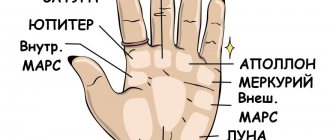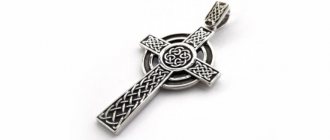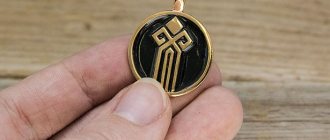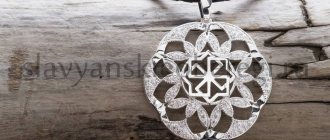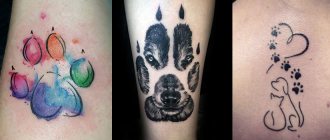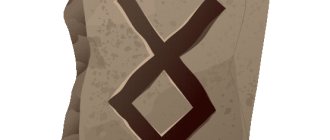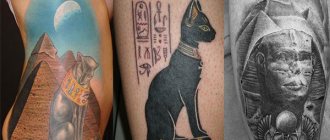Cross among different peoples
Despite its simple form, the symbol is of great importance in the development of human society. Some sources claim that the official history of its origin begins in ancient Egypt and comes from the hieroglyph meaning the word life.
If we dig even deeper, the first image resembling a cross can be considered rock paintings in the form of a man with outstretched arms, belonging to the late Paleozoic era.
Numerous archaeological finds prove that the sign was used in all pagan rituals with the worship of the elements of nature long before the advent of Christianity.
- The peoples of South America believed that with its help evil spirits were driven out. For this reason, they placed newborn children under it.
- The Indian god Krishna had a cross on his hands. It is also the main religious symbol in the Christian church.
- Peoples professing the ancient religion of the Turks still wear it on their foreheads in the form of a tattoo or painted on it. This means submission to the great god Tengri - the owner of the Eternal Sky.
There are a huge number of types and names of the sign in the world. For the Assyrians, it meant the sun and was enclosed in a circle. The Egyptian image adds a ring or loop to it, calling the design the knot of life.
Among the Indo-European peoples, it is better known in the form of a swastika, which symbolizes happiness and eternity. The swastika with clockwise rays is often found in Hinduism and Buddhism. The cross was also often used in the emblems and coats of arms of orders and great rulers.
About the law of the golden ratio
The eight-pointed Orthodox cross in its classic form is built according to the law of the golden ratio. To make it clear what we are talking about, let us dwell on this concept in a little more detail. It is usually understood as a harmonic proportion, which in one way or another underlies everything that is created by the Creator.
One example of this is the human body. Through simple experiment, we can be convinced that if we divide the value of our height by the distance from the soles to the navel, and then divide the same value by the distance between the navel and the top of the head, the results will be the same and amount to 1.618. The same proportion lies in the size of the phalanges of our fingers. This ratio of quantities, called the golden ratio, can be found literally at every step: from the structure of a sea shell to the shape of an ordinary garden turnip.
The construction of proportions based on the law of the golden ratio is widely used in architecture, as well as other fields of art. Taking this into account, many artists manage to achieve maximum harmony in their works. The same pattern was observed by composers working in the genre of classical music. When writing compositions in the style of rock and jazz, it was abandoned.
The power of the sign among the Slavs
The main group of researchers studying the graphical meaning of the intersection of two lines came to the conclusion that for our distant ancestors, such an arrangement of rays indicated the interaction of heaven and earth.
The vertical line is the sky, the horizontal line is the earth. The four directions that emerged indicated the presence of the main elements existing on the planet:
- fire;
- air;
- Earth;
- water.
Since ancient times, the Slavic Vedas have considered the cross a sign that carries a huge sacred meaning. They are sure that the word comes from the root “kres”, meaning fire, which was produced by rubbing crosswise folded sticks. The proof is the name of the tool for making fire - the armchair.
This statement is completely contrary to Christian ideology. There such an emblem is a symbol of torment and suffering, and not a sign of the sacred fire. Followers of Christ wear them on their bodies, trying to prove their love and reverence to God. In return they expect protection from any evil.
The four directions of the cross indicate the main elements existing on Earth
Among the Slavs, the cross indicates the interaction between spirit and matter. It signifies the symbolic movement of the planets around the sun, as well as the solar system itself revolving around the center of the galaxy. The energies circulating in and around the human body, according to the Slavs, are also located in the four-way direction of the rays.
An instrument of death that has become a symbol of life
The Christian cross is an image of the instrument of execution to which Jesus Christ was subjected to a forced sentence imposed by the procurator of Judea Pontius Pilate. For the first time, this type of killing of criminals appeared among the ancient Phoenicians and through their colonists, the Carthaginians, it came to the Roman Empire, where it became widespread.
In the pre-Christian period, it was mainly robbers who were sentenced to crucifixion, and then the followers of Jesus Christ accepted this martyrdom. This phenomenon was especially frequent during the reign of Emperor Nero. The very death of the Savior made this instrument of shame and suffering a symbol of the victory of good over evil and the light of eternal life over the darkness of hell.
Using a symbol for protection
Since ancient times, this pattern has been used in embroidery of clothing and in the construction of houses made of clay, wood, and stone. All kinds of jewelry in the form of crosses or decorated with such a symbol, found during excavations of ancient Slavic settlements, are earrings, bracelets, rings and necklaces, the designs of which necessarily included transverse lines.
In Slavic culture, more than 100 variants of the cross are known, using a variety of shapes and colors of the sign. All of them have a certain magical meaning and are created for use in many life situations.
Mostly women wore this type of jewelry, trying to attract the help of their ancestors and higher powers. Men put it on their body to gain wisdom; the cross protected them and gave them physical strength.
For the Slavs, the cross is the main protective talisman, protecting the one who wears it from the four cardinal directions. The image of the sign with elements of various ornaments makes it a symbol of fertility and shows the distinctive features of each Genus.
Heavenly cross
The meaning of the image of the spear on the cross of Golgotha
The eight-pointed Orthodox cross on monastic vestments is always accompanied by images of a cane with a sponge and a spear. Those familiar with the text of the Gospel of John well remember the dramatic moment when one of the Roman soldiers named Longinus pierced the Savior’s ribs with this weapon and blood and water flowed from the wound. This episode has various interpretations, but the most common of them is contained in the works of the 4th century Christian theologian and philosopher St. Augustine.
In them he writes that just as the Lord created his bride Eve from the rib of sleeping Adam, so from the wound in the side of Jesus Christ inflicted by the spear of a warrior, his bride the church was created. The blood and water spilled during this, according to St. Augustine, symbolize the holy sacraments - the Eucharist, where wine is transformed into the blood of the Lord, and Baptism, in which a person entering the bosom of the church is immersed in a font of water. The spear with which the wound was inflicted is one of the main relics of Christianity, and it is believed that it is currently kept in Vienna, in the Hofburg Castle.
Types of crosses for amulets
The amulet in the form of a cross was the most important and obligatory attribute among the Slavs. It was a symbol of an entire clan and gave the wearer constant support from the ancestors.
Any amulet had additional protective power transmitted by the master who created it. There are several versions of gizmos where such a design was used. They all had their own special power, which they shared with those to whom they belonged. There are 7 main types of Slavic cross.
- Foot and mouth disease (Solar or Solar Cross) - has the most powerful protection, combining the power of the ancestors and the energy of the sun. Used to protect the home and everyone who lives in it. FMD is also worn by those who want to discover their clairvoyant abilities or become a healer.
- Ancestor (Heavenly Cross) is the exact opposite of Foot-and-mouth disease, but has no less power, the meaning of such a symbol is the power of the ancestors and their protection. Intended for help from living and departed representatives of the clan, it gives the protection of higher powers.
- Perun's Cross is a male talisman that gives power, wealth and fertility to the entire family of its owner. Gives men courage and determination.
- The Svarog talisman is an amulet in the form of a star, connecting a male cross with eight rays and a female cross into one. It is a symbol of infinity and the number of priests (magi). It is neutral, so its wearer needs to charge the amulet with his own hands or solar energy. The Star of Svarog protects the owner by taking an energy blow. From time to time the talisman is cleaned by immersing it in holy or spring water.
- Gromovnik - has six rays enclosed in a hexagon or circle - a talisman of warriors with protection from lightning.
- Kolokres - the image is in a circle. It is a sign of the sun and does not allow evil to pass through.
- Square - lines dividing the square into four parts. An earth sign that brings fertility.
What does the cross mean as a symbol?
The interpretation of this symbol in Slavic paganism is a rather controversial point, but a number of sources still agree that the horizontal line means the world of people, and the vertical line is the axis of life.
In addition, it is also interpreted as a time model: the right horizontal line means the past, and the left horizontal line means the future. The vertical crossing this “temporary” line denotes space. Accordingly, the point of intersection of space and time is the present.
ATTENTION! This explanation differs from the interpretation of a similar symbol in monotheistic religions, for example, in Christianity, where the horizontal line is the will of man, suppressed by the will of God (vertical). That is, in such teachings the cross-shaped symbol is considered as a symbol of man’s submission to God, whereas in paganism it simply represents a kind of speculative model of the world (in ideological and temporal terms).
What does the solar cross amulet mean?
The solar cross as a talisman carries powerful energy. The well-known significance attached to the sun's rays is to disperse darkness and evil spirits.
Therefore, this symbol is used as a talisman. But the meaning of the amulet is not limited to this; besides this, it:
- strengthens the energy of the wearer;
- helps to gain confidence in oneself and one’s own abilities;
- helps you find your way and set priorities;
- attracts good luck;
- strengthens family relationships.
BY THE WAY! Another important meaning of the amulet is to help parents raise their children as worthy people by attracting the energy and traditional values of the family.
What does the heavenly cross amulet mean?
The main meaning of the heavenly cross amulet is the protection of the family by the gods. The connection between the clan and the gods among the Slavs is explained by the fact that they believed in the origin of people from the gods (from this it logically follows the desire, through certain actions, for example, wearing a special sign, to attract divine “ancestors” to protect their family).
You may be interested in: Burdock of happiness meaning of the Slavic amulet and proper use
The amulet may also contain additional signs that serve the purpose of more effectively directing energy to protect the wearer’s family.
The main symbol of humanism and philanthropy
Over the millennium that has passed since the time when the Dnieper banks were illuminated by the light of Christ's faith, the Orthodox tradition has undergone many changes. Only its religious dogmas and basic elements of symbolism remained unshakable, the main one of which is the eight-pointed Orthodox cross.
Gold and silver, copper or made of any other material, it protects a believer, protecting him from the forces of evil - visible and invisible. As a reminder of the sacrifice made by Christ to save people, the cross has become a symbol of the highest humanism and love for one's neighbor.
Immortality granted by faith
It is also important to understand why the name of the eight-pointed Orthodox cross is associated with the name of St. Lazarus? The answer to this question can be found on the pages of the Gospel of John, which describes the miracle of his resurrection from the dead, performed by Jesus Christ, on the fourth day after death. The symbolism in this case is quite obvious: just as Lazarus was brought back to life by the faith of his sisters Martha and Mary in the omnipotence of Jesus, so everyone who trusts in the Savior will be delivered from the hands of eternal death.
In the vain earthly life, people are not given the opportunity to see the Son of God with their own eyes, but they are given his religious symbols. One of them is the eight-pointed Orthodox cross, the proportions, general appearance and semantic load of which became the topic of this article. It accompanies a believer throughout his life. From the holy font, where the sacrament of baptism opens the gates of the Church of Christ for him, right up to the gravestone, an eight-pointed Orthodox cross overshadows him.
Orthodox cross - amulet or jewelry?
Amulet or empty thing?
Many people are interested in the answer to the question whether the pectoral cross an ordinary piece of jewelry or is it a strong amulet that protects its owner from the evil eye and various dangers. This issue can be debated endlessly. In this article I will try to cover all aspects of this issue. The cross appeared with the advent of Christianity. It symbolized eternity and was the most powerful amulet even during paganism.
However, it was not customary to wear crosses on the body; they were not intended for this. But after the baptism of Rus', people began to put them on and wear them over their clothes. In our modern times, for believers, a golden pectoral cross is a symbol of service to Christ and it is customary to hide it under outer clothing from prying eyes. During the baptismal ceremony, a pectoral cross is put on babies, which they must wear throughout their lives, even after death it must remain with its owner.
If a pectoral cross is consecrated in a church, then it is a strong amulet, in other cases it is just an ordinary piece of jewelry that adorns your chest. Modern jewelry stores offer a huge assortment of crosses made from different metals and inlaid with precious and semi-precious stones. However, the most popular were and remain golden crosses .
Making pectoral crosses
The production of this type of product is carried out by professional jewelers, but the design of pectoral crosses should be worked exclusively by those artists who have received a blessing for this work in the church.
In the old days, the appearance of a pectoral cross, which was usually worn on the chest, carried a special meaning. Nowadays, some private jewelers are looking for and collecting information related to ancient crosses, since some clients even today want their gold cross to be made taking into account the ancient canons. Some people prefer to wear unique masterpieces of jewelry.
Many argue that gold crosses made in the Art Nouveau style are not a religious symbol, but are a beautiful pendant devoid of any meaning. And in a way, this statement is true. After all, really, what could be the point in products stamped at a factory in huge quantities.
The benefits of wearing a cross
A pectoral cross will bring more benefits when the owner himself endows it with love and care. At its core, a cross should first of all be dear to its owner, and not just because it was made of precious metal. In such cases, the pectoral cross becomes a powerful amulet against the evil eye, black envy and evil forces.
If you want to give a cross bought in a jewelry store the powerful power of a talisman, then first of all you need to consecrate it in the church, since during the consecration ceremony the priest reads special prayers over it asking the Lord to give your cross heavenly power. And as was said above, you must love and treasure your cross, and also treat it as a talisman, and not as a beautiful decoration.
When choosing a gift for ourselves or loved ones from gold pendants, we often give preference to the traditional cross. Why is this happening? What kind of secret force makes us choose this particular product?
It turns out that according to ancient beliefs and legends, every person who wears a pectoral cross is blessed forever by God and the holy martyrs. Wearing a cross on the chest near the heart is not just a tribute to modern fashion, but a manifestation of sincere faith in God and the need for his protection from damage and an evil tongue, evil spirits and the evil eye.
Even a person who does not believe in God, but wears a cross just because it is fashionable, will be protected, despite the lack of faith in him. However, in such cases the protection will be much weaker. A cross is endowed with special amulet power if it is given with sincere love and from a pure heart.
It is customary to give an Orthodox cross for baptism, as well as birthdays, name days, and rest assured, everyone will always be very happy with such a gift. It is not necessary for a child to hang a cross on a gold or silver chain. A very simple silk or nylon rope is also suitable for this. Well, its color will match the color of the cross itself.
If in the process of wearing a pectoral cross, something happens to it, it is bent, broken or lost, then you should not be afraid, because the church does not provide for anything bad or foreshadowing any trouble in this, just calmly purchase a new cross and consecrate his.
Family heirloom
As is customary, we always prefer to buy a gold cross , which can be quite modest. Very often you can see crosses in the form of a small decoration with an original ornament, with or without a crucifix. Also, the cross can be an exquisite and even luxurious product, large in size, with an openwork pattern, with the insertion of precious or semi-precious stones and various coatings, which will make it truly unique and exclusive. Such a rather complex work can be performed by a talented master jeweler to an individual order, and your cross will only be in a single copy.
A cross given to a child during the baptism ceremony is endowed with special power. We keep such crosses all our lives, along with photographs and our first hair. Very often crosses become family heirlooms, passed down from generation to generation and carefully preserved. And if suddenly your family does not yet have such a holy relic, then, without hesitation, become its founder.
Orthodox cross photo:
Symbolic inscriptions on the monastic cross
Those who see the monastic eight-pointed Orthodox cross for the first time often have questions related to the inscriptions inscribed on it. Specifically, these are the IC and XC at the ends of the middle bar. These letters stand for nothing more than the abbreviated name – Jesus Christ. In addition, the image of the cross is accompanied by two inscriptions located under the middle crossbar - the Slavic inscription of the words “Son of God” and the Greek NIKA, which means “winner”.
On the small crossbar, symbolizing, as mentioned above, a tablet with an inscription made by Pontius Pilate, the Slavic abbreviation ІНЦІ is usually written, meaning the words “Jesus of Nazareth, King of the Jews,” and above it - “King of Glory.” It became a tradition to write the letter K near the image of a spear, and T near the cane. In addition, from about the 16th century, they began to write the letters ML on the left and RB on the right at the base of the cross. They are also an abbreviation and mean the words “The Place of the Execution is Crucified.”
In addition to the listed inscriptions, it is worth mentioning two letters G, standing to the left and right of the image of Golgotha, and being the initial ones in its name, as well as G and A - Head of Adam, written on the sides of the skull, and the phrase “King of Glory”, crowning the monastic eight-pointed Orthodox cross. The meaning contained in them fully corresponds to the Gospel texts, however, the inscriptions themselves can vary and be replaced by others.
